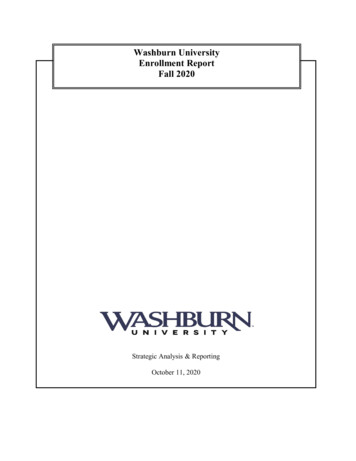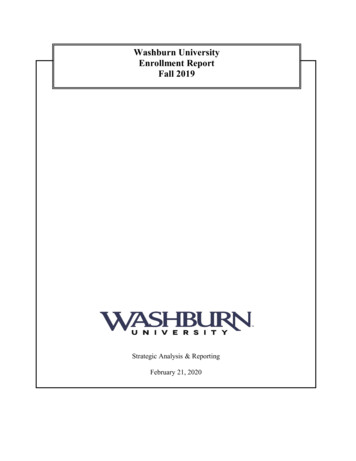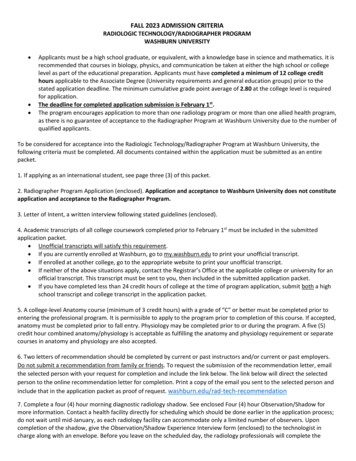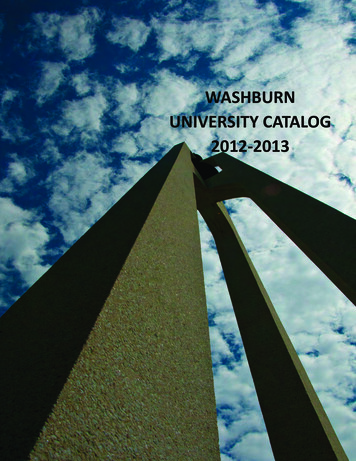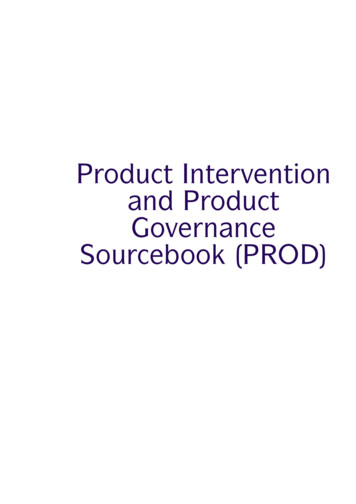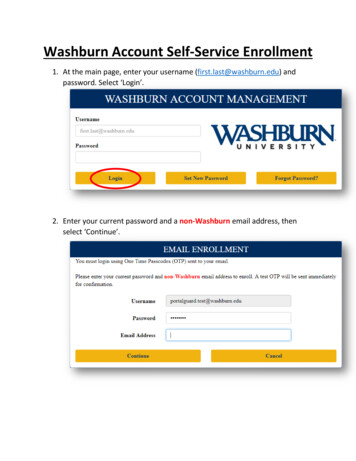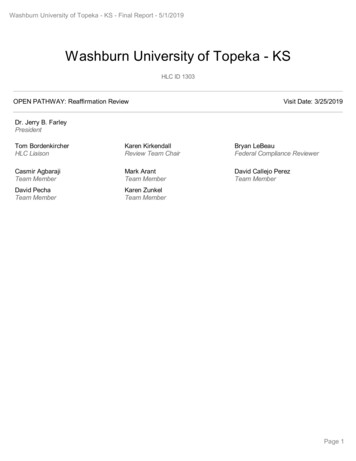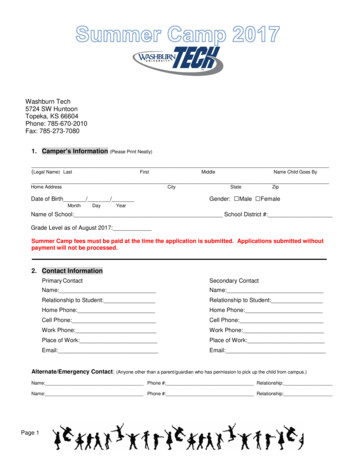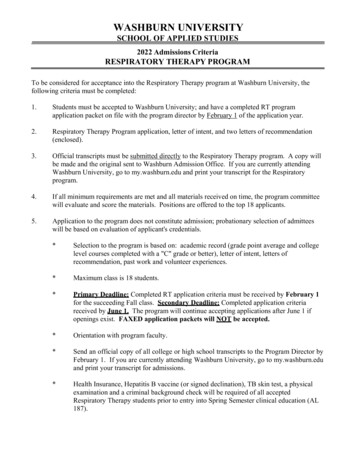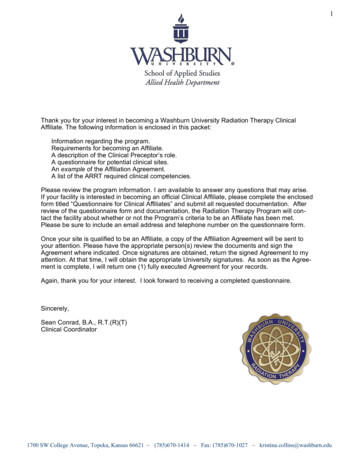
Transcription
1Thank you for your interest in becoming a Washburn University Radiation Therapy ClinicalAffiliate. The following information is enclosed in this packet:Information regarding the program.Requirements for becoming an Affiliate.A description of the Clinical Preceptor’s role.A questionnaire for potential clinical sites.An example of the Affiliation Agreement.A list of the ARRT required clinical competencies.Please review the program information. I am available to answer any questions that may arise.If your facility is interested in becoming an official Clinical Affiliate, please complete the enclosedform titled “Questionnaire for Clinical Affiliates” and submit all requested documentation. Afterreview of the questionnaire form and documentation, the Radiation Therapy Program will contact the facility about whether or not the Program’s criteria to be an Affiliate has been met.Please be sure to include an email address and telephone number on the questionnaire form.Once your site is qualified to be an Affiliate, a copy of the Affiliation Agreement will be sent toyour attention. Please have the appropriate person(s) review the documents and sign theAgreement where indicated. Once signatures are obtained, return the signed Agreement to myattention. At that time, I will obtain the appropriate University signatures. As soon as the Agreement is complete, I will return one (1) fully executed Agreement for your records.Again, thank you for your interest. I look forward to receiving a completed questionnaire.Sincerely,Sean Conrad, B.A., R.T.(R)(T)Clinical Coordinator1700 SW College Avenue, Topeka, Kansas 66621 (785)670-1414 Fax: (785)670-1027 kristina.collins@washburn.edu
2The Radiation Therapy program is administered through the School of Applied Studies, Department of Allied Health. The program curriculum at Washburn is a JRCERT accredited, online13-month certificate of completion program. Upon successful completion of the pro-gram,graduates The Radiation Therapy program is administered through the School of Ap-pliedStudies, Department of Allied Health. The program curriculum at Washburn is a JRCERTaccredited, online 13-month certificate of completion program. Upon successful completion of theprogram, graduates are registry eligible with the American Registry of Radi-ologic Technologists(ARRT). Classes begin in late June and finish the following July. The program consists of 40credit hours of didactic courses and clinical education.Students complete didactic courses online and participate in clinical education at a Washburnaffiliated radiation therapy center. Clinical consists of unpaid experience. In the fall and springsemesters clinical hours are Tuesday-Thursday (8am-4pm) and Friday (8am-12pm). The win-terintersession (a component of the spring semester) consists of approximately three weeks inDecember and January in which student’s complete clinical hours Monday-Friday, 8am-4pm. Inthe summer semester, clinical is scheduled Monday-Thursday (8am-4pm) and Friday(8am-12pm).Kristina Collins, MHS, BHS, RT(R)(T)Program DirectorMHS, Washburn University, 2019BHS, Washburn University, 2009Radiation Therapy, Washburn University, 2009Radiologic Technology, Washburn University, 2008785-670-1414Kristina.collins@washburn.eduSean Conrad, B.A, RT(R)(T)Clinical CoordinatorB.A, University of Kansas, 2007Radiation Therapy, Washburn University, 2012Radiologic Technology, Washburn University, 2011785-670-1448Sean.conrad@washburn.eduProgram MissionThe Radiation Therapy Program is focused on the development of qualified radiation thera-pistswho provide optimum patient care through technical competency and professional con-duct.PROGRAM EFFECTIVENESS OUTCOMESOutcome 1: Students will complete the program.Outcome 2: Graduates will pass the national certification exam on the first attempt within 6months of graduation.Outcome 3: Graduates will be gainfully employed in radiologic sciences within 12 months ofgraduation.Outcome 4: Graduates will be satisfied with the overall quality of the program.Outcome 5: Employers will be satisfied with the overall competency of program graduates.GOAL 1 – PROGRAM GRADUATES WILL BE CLINICALLY COMPETENT.Outcome 1: Students will analyze pertinent data from treatment planning documents.Outcome 2: Students will accurately positions patients for treatment delivery.Outcome 3: Students will evaluate images using various imaging technologies (MV, kV,CBCT) to ensure proper patient alignment.
3GOAL 2 – STUDENTS WILL DEMONSTRATE WRITTEN AND ORALCOMMUNICATION SKILLS.Outcome 1: Students will demonstrate written communication skills.Outcome 2: Students will provide patient education within scope of practice.GOAL 3 – STUDENTS WILL DEMONSTRATE CRITICAL THINKING SKILLS.Outcome 1: Students will solve challenges related to non-routine clinical situations.Outcome 2: Students will demonstrate ability to perform specialized procedures.GOAL 4 – STUDENTS WILL DEMONSTRATE PROFESSIONAL WORK STANDARDS.Outcome 1: Students will exhibit professional standards and behaviors.Outcome 2: Students will assess the importance of professional development.Program assessment data is available on the program’s website under the Quality Indicators &Accreditation menu option (www.washburn.edu/radiation-therapy) as well as at the following locationon the Joint Review Committee on Education in Radiologic Technology (JRCERT)’s website: ty/)AccreditationThe Radiation Therapy Program is accredited by the Joint Review Committee on Education in Radiologic Technology (JRCERT). Joint Review Committee on Education in Radiologic Technology, 20North Wacker Drive, Suite 2850, Chicago, Illinois 60606-3182 , (312) 704-5300, E-mail:mail@jrcert.orgState Authorization: The admission of students into a Washburn University degree or certificatepro-gram offered online or at sites outside of Kansas is contingent upon the University's compliancewith any applicable regulations or laws enacted by those states in which the students reside. TheUniversi-ty is reviewing the regulations imposed by other states in which our current students resideto deter-mine their applicability and the feasibility of complying with such regulations in the future.Admission CriteriaAn applicant must be a graduate of an accredited Radiologic Technology program, possess a minimum ofan Associate Degree from an institution that is accredited by an acceptable accrediting body according tothe ARRT, and hold the professional designation of RT(R). Specific coursework evaluated in the application review process includes: human anatomy and physiology, mathematics (math course descriptionshould include content such as real number systems, algebra of sets, exponents, equations and inequalities, polynomial functions, graphing, radical expressions, operations, inverses of function, equations oflines and systems of linear equations, logarithmic and trigonometric functions), written communication(composition), verbal communication (communication or public speaking/speech course), and radiationphysics from radiology program.Students who have not yet met these requirements, but are in the process of doing so may also beconsid-ered for admittance; however, acceptance will be contingent on meeting all admissionrequirements prior to the program’s start date.Acceptance is conditional on the following: Confirmation of acceptable clinical placement. Completion of a radiologic technology program. Verification of an associate degree or higher from an educational institution accreditedby a body acceptable to the ARRT. Professional designation by the ARRT as a Registered Radiologic Technologist (RTR). Successful completion of a 10-panel drug screen. Successful completion of a criminal background check. A criminal background check will be required ofall accepted Radiation Therapy students prior to the program start date. Successful completion of theRadiation Therapy program requires participation in clinical practicum courses. Students can only beplaced in clinical practicum courses after a background check (at their expense) has been completedwhich discloses they do not present a criminal history of:a. convictions of laws regulating controlled substances*;b. convictions, at the felony level of crimes, as defined under Kansas Criminal Code (K.S.A. 21-3101et seq.) and amendments thereto, which are crimes against persons, crimes against property, orsex offenses;c. conviction of an offense requiring registry as a sex offender under the Kansas OffenderRegistry Act or any federal, military or other state law-requiring registry;d. conviction, at the felony level of crimes, involving moral turpitude which include but are not limited to: perjury, bribery, embezzlement, theft, and misuse of public funds.
4*Exception: Persons who have been convicted of a misdemeanor illegal drug offense may bepermitted to participate in the clinical practicum pursuant to the process for Management of Misdemeanor Illegal Drug Exception set out below.Management of Misdemeanor Illegal Drug Exception If a background check report demonstrates a discrepancy, the Clinical Coordinator will contactthe university contact who has access to the details of background check reports. The university contact will determine the cause of the discrepancy and communicate it to theClinical Coordinator. The Clinical Coordinator will report findings from the university contact to the Program Director. The university background check policy will be applied as follows: If offense is related to items a-d of the background check policy, the student will not bepermitted to start the program. If offense is a misdemeanor illegal drug offense and the student is currently on probation for the offense, the student will not be permitted to start the program. If offense is a misdemeanor illegal drug offense and the student is NOT currently onprobation for the offense, the student will be provided the following option. Student may disclose the misdemeanor illegal drug offense to the Clinical Supervisor at the assigned clinical site. Clinical Coordinator will follow-up with the Clinical Supervisor at the assignedclinical site about the student’s disclosure. If the disclosure prohibits student placement at the clinical site, the student willnot be permitted to start the program. If the disclosure does NOT prohibit student placement at the clinical site, thestudent will be permitted to start the program and student will be advised tocomplete the ARRT Pre-Application Ethics Review process - ionWhy Major in Radiation Therapy at Washburn University? Dedicated to excellence in teaching, Washburn University today is recognized as an outstanding public, urban learning environment. Washburn University began in 1865 as Lincoln College, a school established by the Congregational Church. Lincoln College became Washburn College in 1868 in recognition of the financial support of New England philanthropist, Deacon Ichabod Washburn. In 1941, the citizens ofTopeka voted to make Washburn a municipal university. Our educational objectives are to prepare individuals for careers and further study in a varietyof disciplines for a lifetime of continuous learning. Washburn has a reputation as a "teaching" university rather than a "research" institution. Morethan 90% of our faculty holds doctoral degrees or the highest degree available in their discipline.Statement of Non-Discrimination: It is the policy of Washburn University to assure equal educational and employment opportunity to qualified individuals without regard to race, color, religion,age, national origin, ancestry, disability, sex, marital or parental status or sexual orientation.
5Clinical Affiliation Requirements Accredited by TJC or equivalent accreditation. (See Question 2e for appropriateaccreditation mechanisms)2. Linear accelerator(s) with electron capabilities.3. CT simulation equipment.4. Computerized treatment planning.5. Medical physicist available on-site daily or on a weekly basis.6. Full-time Oncologist(s).7. Minimum patient load of 20 patients per linac per day with a variety of procedures and cancertypes.8. Routine imaging using a variety of technologies include MV, kV, and CBCT or MVCT etc.9. Radiation therapy staff that is willing and able to provide support, guidance and a positive learning environment to the student. This may be difficult if the department is short staffed or if staff isresistant to training students.10. Able to provide the student with the opportunity to observe, assist/perform all aspects ofradiation therapy including, but not limited to: Nursing: Patient consults, status checks, follow ups, dietician/nutritionist consults, socialwork consults. Block Room: MLC is the primary mode of field shaping today, however, graduates of ourprogram must have experience with electron custom block construction. Brachytherapy: Students are to participate in brachytherapy experiences and completecase studies and competency related to either LDR or HDR brachytherapy. Special Procedures: All students will log experience with stereotactic and motion management procedures. The ARRT requires competencies for SBRT/SRS treatments, and a special simulation procedure. The ARRT requires competencies (which may be simulated) forTotal Body Irradiation (photon or electron) and Craniospinal Axis Irradiation. Simulation: CT units are the standard for simulation today. When CT simulation is used,students must follow the CT image data into the treatment planning computer or workstationto be involved in the virtual simulation process. During simulation rotations, students will logimmobilization device fabrication activities. Students will complete 6 simulation competencies. Treatment Room: All aspects of treatment delivery including patient education, patient alignment , diode readings, imaging, image critique, new starts, emergency cases, chart review,scheduling, and billing. Students are not allowed to activate the beam during the fall semester and in the spring/summer semesters beam activation is left to the facility’s discretion.Even when the student is not activating the beam, the student MUST be involved in all activity up to beam activation and following beam deactivation (accessing chart, reviewing prescription, documentation, selecting fields for treatment, acquiring images, charging etc.) Dosimetry: Students must complete competencies related to the completion of basic calculations as well as computer generated isodose plans. Image Review: Students need frequent opportunity to critique and analyze the accuracy ofpositioning based on images. Students will complete 3 imaging competencies. Tumor Board: This is a very beneficial learning experience, which is recommended. Quality Assurance Procedures: Students will be required to perform quality control procedures, demonstrate competence in five quality control activities, demonstrate ability to ensure that treatment information is complete and accurate, and participate in the monthlyquality control checks with the physicist.11. Site must designate a registered Radiation Therapist as the Clinical Preceptor. This should besomeone who is able to commit time to be a frequent source of support and guidance for thestudent. This individual must be willing to provide effective and timely feedback. Activities of theClinical Preceptor include submission of competency and professional development evaluations and verification of time records. All evaluations and time records are submitted in Trajecsys (an online clinical management system). The Clinical Preceptor will be the primary contact for the program and shall communicate concerns about a student’s clinical behavior, professionalism, and technical skills to the program Clinical Coordinator in a timely fashion.12. Other staff registered radiation therapists at the clinical site must be willing to also participate inmentoring and instructing students. The success of clinical education is highly dependent onthe staff’s commitment to creating a constructive learning environment.13. In some cases an exam proctor from the clinical site may be needed. Advanced warning wouldbe granted to the clinical site if this circumstance arises.
6The student can/should work with a variety of registered radiation therapists, so the responsibilityof the student is not completely on the Clinical Preceptor The completion of performance evaluations may be completed by the Clinical Preceptor or by the registered radiation therapists withwhom the student has directly been working. It is the Clinical Preceptor who will review the resultsof professional development evaluations with the student and provide guidance. The Clinical Preceptor will also check-in with the student, organize rotations, provide feedback, answer questions,and mentor professional behavior. At all times the student must be directly supervised byregistered radiation therapist or appropriately credentialed professionals. Students maynot be used as staff or considered as staffing relief and all student clinical educationhours are unpaid.A Clinical Preceptor must possess the following qualifications:1. Credentialed in radiation therapy by the ARRT.2. A minimum of two years experience as a RT(R)(T) in a Radiation Oncology Department.3. Demonstrate proficiency in educational methodologies.a. previous experience working with studentsb. training (formal or continuing education) regarding the education of studentsResponsibilities Include:1. Student instruction and supervision.2. Evaluation of student progress in clinical skill development and competency.3. Reporting student progress or concerns regarding progress to program Clinical Coordinator.4. Providing student with regularly scheduled feedback.5. Providing scheduled learning opportunities if the student asks for additional help.6. Familiarity with program goals and clinical objectives.7. Providing clinical staff the means to be familiar with program goals and clinical objectives.8. Providing new staff radiation therapists with an orientation to the education program.9. Supervising the clinical attendance of students.10. Providing clinical staff with the opportunity to provide suggestions to the program.Clinical Education Details: All of the following information is included in the Clinical Preceptor’smanual. Clinical sites hosting a Washburn University student in a given academic year will receive an updated Clinical Preceptor’s manual at least 4 weeks prior to the date students report toclinical. The Clinical Preceptor’s Manual will be provided in electronic and paper formats. TheProgram and Clinical Manual (which contains the Clinical Preceptor’s manual) and programschedules are available online at www.washburn.edu/radiation-therapy.Treatment Delivery: Students must demonstrate competence in 16 ARRT required treatment competencies thatwill be completed through the year. Thirteen procedures must be demonstrated on patients, 3of the required 16 procedures may be performed under simulated conditions. Additionally,students will retest on certain procedures to demonstrate continued competency. Students must complete 3 imaging competencies that will be completed through the year utilizing MV, KV, and ConeBeam CT systems. Students must complete a treatment chart check competency and a verification simulationcompetency. Students will log stereotactic treatment procedures and will complete a SRS/SBRT competency. Students will log motion management experiences. These experiences may be accomplishedthrough a variety of techniques (respiratory gating, abdominal compression or forced shallow breathing, or deep breath holds).Simulation: Students must complete 6 ARRT required simulation competencies that will be completedthrough the year, all of which must be completed on actual patients. In addition, students mustdemonstrate competence in the fabrication of a thermoplastic mold and custom immobilizeaction device for the thorax or abdomen/pelvis. Students will complete the ARRT requiredSpecial Simulation competency.
7Dosimetry: The ARRT identifies 6 dosimetry competency categories related to computerized treatmentplanning, photon beam calculations, and electron beam calculations. Students will also bechallenged to develop skills in treatment plan interpretation and review. Quality Assurance:Students must complete 5 quality control activities. Students will also completecompetencies related to the review of treatment data to ensure com-pleteness and accuracy.Brachytherapy: Students also must observe a minimum number of brachytherapy procedures (low dose rateor high dose rate) and complete 1 brachytherapy competency. Electronic brachytherapy doesnot fulfill this requirement.Nursing & Patient Care:Students will need to observe consultations, status checks, and follow-up appointments. Additionally students should sit in on dietary/nutrition consults and social work consults to gain abetter understanding of the comprehensive care offered to cancer patients. The ARRT requires students to demonstrate competence in 4 patient care activities: CPR, Vital Signs, O2Administration, and Patient Transfer. Special Procedures: The ARRT has defined 4 participatory procedures: TBI, Craniospinal, Brachytherapy, SBRT/SRS, Special Treatment Simulation Procedure, & Custom Block. These may be infrequent,yet critical. Participation means that the student takes an active role in the procedure and understands the critical concepts that are vital to the procedure. These may be completed undersimulated conditions, if necessary.Tumor conferences and safety trainings (or other related activities) serve to enhance the clinicaleducation experience and offer students a broad scope of radiation therapy as they strive to develop entry-level skills.
8Questionnaire for Clinical AffiliatesWashburn University- Radiation Therapy ProgramDate:1. Why is your facility interested in becoming or continuing as a Clinical Affiliate of Washburn University’s Radiation Therapy Program?2. Facility Information:a. Facility Name:b. Facility Address:c. Facility Supervisor: Phone:Email:d. Does the director/supervisor wish to be included on program email updates?e. Accreditation: Is your site accredited by any of the following accreditation mechanisms: ACRO (American College of Radiation Oncology), ACR (American College of Radiology) AAAHC (American Association for Ambulatory Health Care) TJC (The Joint Commission) DNV Healthcare, Inc. HFAP (Healthcare Facilities Accreditation Program,) State-issued license, Tube/Linac Registration (Acceptable for free-standing clinics)If yes, by which organization?3. Staffing: Please respond to the following as they relate to the organization/staffing of your department.a. How many licensed Radiation Oncologists?b. Is there a licensed Radiation Oncologist on site daily?c. How many registered Oncology Nurses?d. How many certified Medical Physicists?e. How often is the Medical Physicist at facility during workday hours?f. How many certified Dosimetrists?g. How many registered Radiation Therapists?h. Is there a Dietician on site or available to patients?i. Is there a Social Worker on site or available to patients? It is proven that the clinical affiliate/student relationship is most productive if the clinical site staff is interested and willing to participate in the education of a radiation therapy student. Is the staff interested and willingto help guide a student through the clinical aspect of the program?
9 It is proven that the clinical affiliate/student relationship is most productive if the clinical site staff is interestedand willing to participate in the education of a radiation therapy student. Is the staff interested and willingto help guide a student through the clinical aspect of the program? Does the staff understand that a Radiation Therapy Student will gain repeated hands-on experience relate tothe follow rotations: clerical, nursing, block room, treatment room, simulation, brachytherapy, dosimetry,and quality control rotations throughout the program year? Does the administration & staff understand that students are not to be used as staff or considered whenmaking staffing decisions and that student clinical education hours are unpaid?4. Clinical Preceptor Information: Identify 1 registered Radiation Therapist, with a minimum of 2 years workexperience as a radiation therapist, with experience working with students, or with continued education orformal education focused on teaching/learning to serve as the Clinical Preceptor. A description of this roleis contained within this packet. Preferably this is a therapist who has a natural ability to teach, has had positive outcomes when mentoring students, and is willing to become familiar with Washburn’s Radiation Therapy program. Please include the name of the individual as well as relevant contact information below. Alsoprovide a copy of the designated Clinical Preceptor’s and a complete resume using the form provided in the packet.Name: Phone:Email:Name of Designated “Backup” Clinical Preceptor:Email of Designated “Backup” Clinical Preceptor:5. Is your facility or organization affiliated with another Radiation Therapy Educational Program? If yes,please indicate the name of the school/program, the number of students placed at your facility per academic year, as well as the length of student rotations.6. Equipment: (describe the equipment in the department, please include manufacturer & model)a. Linear Accelerators):b. What is the average daily patient load per linear accelerator per day ?c. Image-Guidance ( include all available methods: MV, kV, CBCT, MVCT, Ultrasound, MRI):d. Stereotactic procedures (SRS, SRT, SBRT):e. Motion management (Gating, Breath Holds, Abdominal Compression):
10f. Simulator (Specify any modalities a student would participate in: CT, MR, PET):g. Treatment Planning System:h. Record and Verify System:i. What form of brachytherapy (LDR or HDR) is available at your facility?*If brachytherapy is NOT performed at your facility are you able to provide contact information of anysuggested locations for this experience? Please list facility name, address,& phone:i. Are there any planned updates/changes at your facility in the near future? If so, please explain andprovide projected dates:7. Other Considerations:a. After reviewing the ARRT requirements (enclosed), please indicate whether the student(s) could gainrepeated hands-on experience with the various ARRT defined procedures to meet the ARRT competencyrequirements?b. Could a student gain block cutting experience (photon or electron) at your facility (despite MLC capabilities)?c. Could a student participate in chart rounds?d. Could a student participate in quality control testing of equipment (linac and CT sim)?e. Does your site treat pediatric patients?f. NOTE: Clinical sites provide a radiation detection device to each student per the affiliation agreement.Students will be required to review the device report at the clinical education site in alignment with theinterval during which devices are collected. Please respond whether your site collect the staff’s radiation detection badges on a quarterly or on a monthly basis.g. Please note that appropriate documentation must be submitted on ALL clinical sites, including mainoffices and satellite offices. Does your site have a satellite office/off-site location the students will rotateto? If yes - please list facility name, address, phone:g. Is there anything more you would like to share about your facility?
11Please provide the following documents to:Sean ConradSean.conrad@washburn.eduOr via USPS to:Sean ConradWashburn UniversityAllied Health Department1700 SW CollegeTopeka, KS 666211. Completed questionnaire form;2. A letter, certificate, or print out demonstrating the facility’s department’s current accreditation;3. Curriculum Vitae for the Clinical Preceptor using the attached formbeginning on page 12;4. Copy of the ARRT certification of individual who will be serving asthe Clinical Preceptor
Joint Review Committee on Education in Radiologic Technology20 N. Wacker Drive, Suite 2850Chicago, IL 60606-3182312.704.5300 (Fax) 312.704.5304www.jrcert.orgClinical Preceptor Curriculum VitaeI.General InformationFull Name/Credentials, i.e., R.T.(R)City and State of ResidenceII. Experience in the Professional Field, Starting with the Most RecentJob TitleName of CompanyCity and StateDates of Employment, i.e., June2018 - PresentDuties, Including Supervision,Instruction, and Evaluation ofStudentsExperience in the Professional Field (cont’d)Job TitleName of CompanyCity and StateDates of EmploymentDuties, Including Supervision,Instruction, and Evaluation ofStudentsJRCERT Template For Clinical Preceptor Curriculum Vitae (06/2021)
Experience in the Professional Field (cont’d)Job TitleName of CompanyCity and StateDates of EmploymentDuties, Including Supervision,Instruction, and Evaluation ofStudentsExperience in the Professional Field (cont’d)Job TitleName of CompanyCity and StateDates of EmploymentDuties, Including Supervision,Instruction, and Evaluation ofStudentsExperience in the Professional Field (cont’d)Job TitleName of CompanyCity and StateDates of EmploymentDuties, Including Supervision,Instruction, and Evaluation ofStudentsJRCERT Template For Clinical Preceptor Curriculum Vitae (06/2021)
Experience in the Professional Field (cont’d)Job TitleName of CompanyCity and StateDates of EmploymentDuties, Including Supervision,Instruction, and Evaluation ofStudentsExperience in the Professional Field (cont’d)Job TitleName of CompanyCity and StateDates
Radiologic Technology, Washburn University, 2008 785-670-1414 Kristina.collins@washburn.edu Sean Conrad, B.A, RT(R)(T) Clinical Coordinator B.A, University of Kansas, 2007 Radiation Therapy, Washburn University, 2012 Radiologic Technology, Washburn University, 2011 785-670-1448 Sean.conrad@washburn.edu Program Mission The Radiation Therapy .
